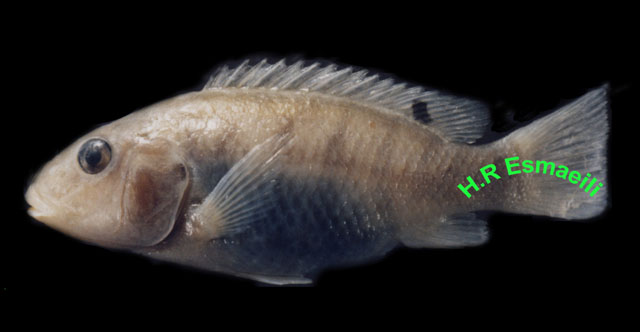| Cichlidae (Cichlids), subfamily: Pseudocrenilabrinae |
| 9.73 cm SL (male/unsexed) |
|
benthopelagic; freshwater; brackish |
| Asia: Southern Iran above the Straits of Hormuz. |
|
Dorsal spines (total): 14-16; Dorsal soft rays (total): 9-11; Anal soft rays: 6-9; Vertebrae: 28-30. Diagnosis: dental field on lower pharyngeal bone nearly circular; teeth of lower pharyngeal bone of uniform size, not enlarged medially; cheek, operculum, belly, isthmus and area between pectortal and pelvic fin bases naked or poorly scaled; anal and dorsal fins rounded posteriorly; pectoral fins short, not reaching vent; scales cycloid, with granular posterior circuli bearing rounded or irregular protuberances; inferior apophysis for support of swimbladder centred around 4th vertebra; mesethmoid not meeting vomer; median length of lower pharyngeal bone 31.8-40.9% length of head; pharyngeal blade/median length toothed area 0.6-1.0 (Ref. 36597). |
| Restricted to salty streams (Ref. 12251, 36597), rarely in freshwaters (Ref. 36597), which are constantly warm, unshaded, usually with muddy bottoms, with little vegetation other than encrusting algae, and are subject to massive flooding during winter rains (Ref. 12251, 36597). Stomach contents consist of various algae (including diatoms) and detritus, indicating that it feeds on bottom deposits (Ref. 36597) and by scraping aufwuchs (Ref. 12251, 36597). This maternal mouthbrooder can brood up to 38 large eggs; females carry eggs in March (Ref. 12251, 36597). Because of the restricted range of this fish and the continual warfare and oil pollution in the area, this fish may be well on its way to extinction (Ref. 12251). |
|
Not Evaluated (N.E.) Ref. (130435)
|
| harmless |
|
Source and more info: www.fishbase.org. For personal, classroom, and other internal use only. Not for publication.

